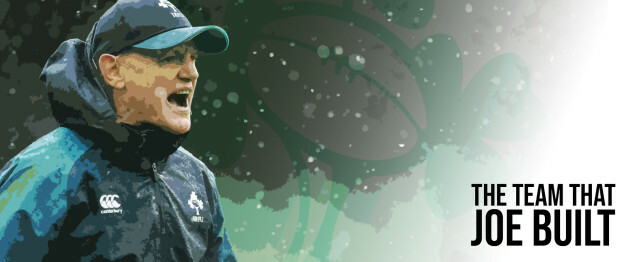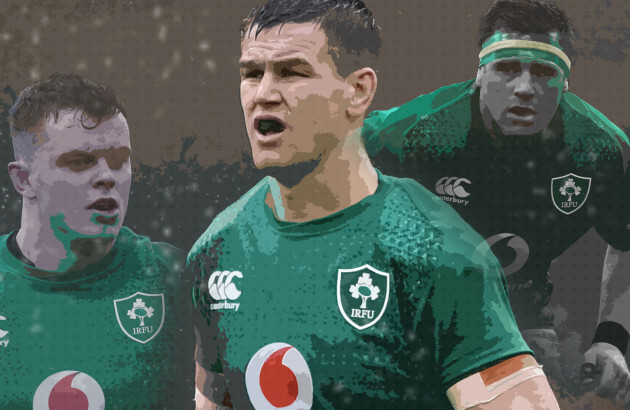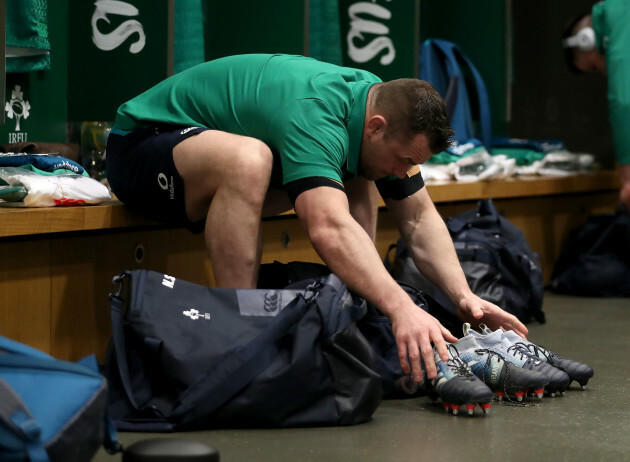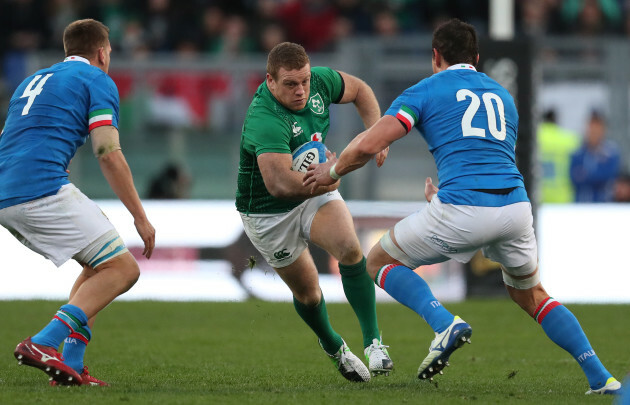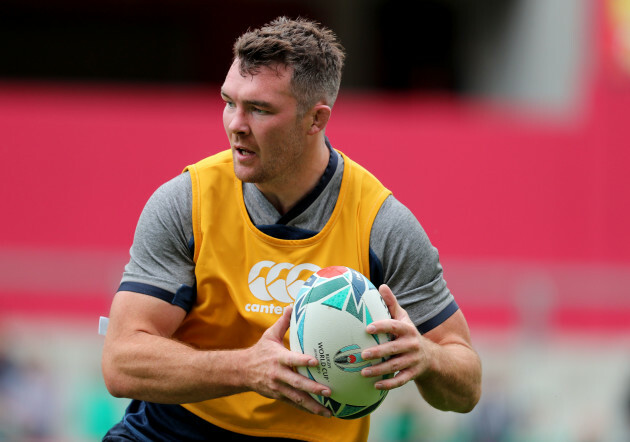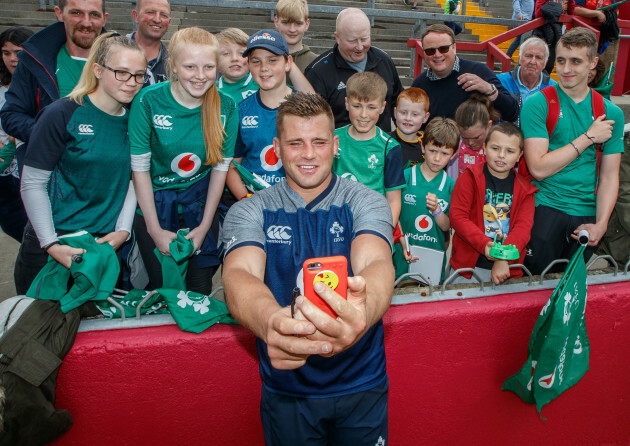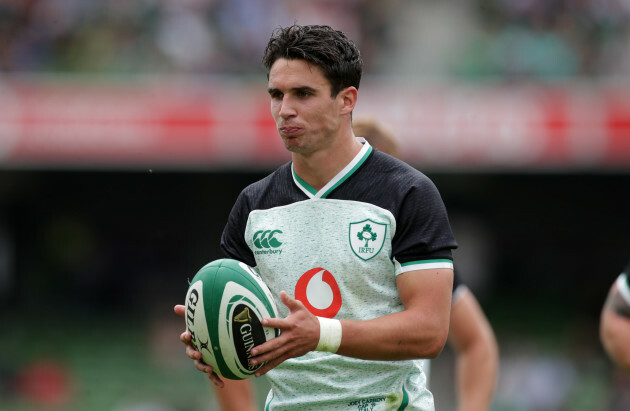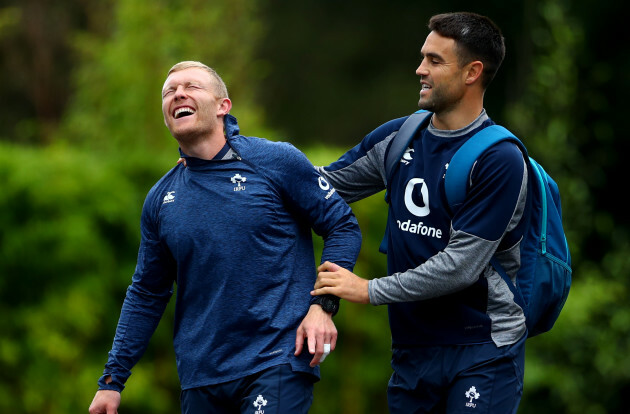JOE SCHMIDT IS unlikely to forget the exasperation of the 2015 World Cup, when Ireland’s quarter-final defeat to Argentina marked the lowest point in his largely glittering tenure as head coach.
The 53-year-old has guided Ireland to Grand Slam glory, two other Six Nations titles, their first- and second-ever wins over the All Blacks, series success Down Under against Australia, and a maiden Test win on South African soil.
Named the World Rugby coach of the year in 2018, Schmidt heads into the last chapter of his time in charge of Ireland at the upcoming World Cup in Japan with one more big box to tick.
Finally helping Ireland beyond the quarter-final stages of the competition would be a success, but the ceaselessly ambitious Schmidt is likely to have an even greater achievement in mind.
Ever since that 2015 agony against Argentina – when Ireland were shorn of five key players, perhaps their five most important players, through injury – Schmidt will have had Japan in his thoughts.
While always focusing on short-term goals like securing that 2018 Grand Slam and knocking off the All Blacks, Schmidt has also been planning and plotting for this year’s World Cup, developing his squad, and building cohesion and experience.
He carried a core group of players forward from the 2015 World Cup, with the likes of Conor Murray, Rory Best, Johnny Sexton, Peter O’Mahony, Rob Kearney and Keith Earls remaining key men today.
Others involved in that tournament, perhaps most notably Tadhg Furlong, have grown into major forces in the Test arena.
Schmidt has supplemented his squad with energetic new blood, most notably in the shape of James Ryan, Jacob Stockdale, and Andrew Porter – all of whom played in the Ireland U20 team that reached a World Cup final in 2016.
Young players above and below that age grade – such as Joey Carbery and Jordan Larmour – have also become familiar figures, underlining the quality of the clubs, schools, academy and provincial systems that feed the top level of Irish rugby.
Another strand for Schmidt has been players who have qualified for Ireland on residency grounds, with CJ Stander and Bundee Aki quickly developing into key men during this World Cup cycle. Jean Kleyn now the latest to come into contention.
More recently, the IRFU has put a focus on its IQ Rugby branch, with the likes of Will Addison moving to these shores, although its real value may only be seen in the next World Cup cycle.
All in all, it has been a fascinating four-year journey for Schmidt’s Ireland as he has attempted to build a squad deep enough to contend for World Cup glory.
The Ireland boss still has the demanding challenge of naming his final 31-man group next month, but it is instructive to reflect on who he can choose – as well as who he has been deprived of – with only weeks left until the official announcement.
Below, we work through each position on the pitch, detailing how many minutes of Test rugby players have amassed from the 2016 Six Nations up until the time of publishing.
It’s important to underline that injury has often denied players the chance to be selected, but the hope is to paint a picture of how Schmidt has gone about putting together a balanced group of players that can compete in Japan.
It’s also crucial to note that experience during this World Cup cycle is not the only thing that indicates a player’s value. Form and character are among other vital factors, and there is no reason why a player who hasn’t featured extensively over the past four years could not make a major impact in Japan.
Loosehead prop:
Schmidt took only two looseheads to the last World Cup in Jack McGrath and Cian Healy, and they have remained his frontline options for this World Cup cycle.
McGrath was the first-choice loosehead in 2016 and 2017 but 31-year-old Healy, having come extremely close to retirement in 2015, returned to his best in stunning fashion for the 2018 Grand Slam and is now the clear number one heading into Japan.
29-year-old McGrath had a difficult 2018/19 campaign and Munster’s Dave Kilcoyne, who has racked up 393 minutes in this cycle, is a strong contender to travel to Japan behind Healy.
Healy and 30-year-old Kilcoyne were Ireland internationals before Schmidt took over in 2013, but McGrath made his debut in the head coach’s first November Test window.
The only other players capped at loosehead in this World Cup cycle have been Munster’s James Cronin – for seven minutes off the bench in the 2016 Six Nations – and Finlay Bealham, who made his debut as a loosehead off the bench against Italy in 2016.
Bealham covered loosehead from the bench on two other occasions that year without getting game time but has already been cut from this year’s World Cup squad.
Andrew Porter, an outstanding loosehead at Ireland U20 level, is set to be the tighthead who can flip to the other side of the scrum in the event of an emergency in Japan – having done so in the first warm-up game against Italy two weekends ago.
Minutes in 2019 World Cup cycle:
1530 Jack McGrath
1288 Cian Healy
393 Dave Kilcoyne
40 Andrew Porter
15 Finlay Bealham
7 James Cronin
Tighthead prop:
Mike Ross and Nathan White were Ireland’s frontline tightheads immediately post-2015 World Cup but played their final Test campaigns in 2016, White bowing out after the Six Nations and Ross playing for the last time on the summer tour of South Africa.
Furlong, first capped just before the 2015 World Cup, took over as Ireland’s first-choice tighthead thereafter and has developed into one of the best in the world. A product of the Leinster Youths system, having developed at New Ross RFC, Furlong was a natural choice to succeed Ross.
Schmidt used Bealham as Furlong’s back-up initially, before Munster’s John Ryan was capped in the November 2016 Tests and provided cover for Furlong throughout 2017, as well as starting three games on the tour of the US and Japan that summer.
The emergence of the explosive Porter – first capped on that same tour – began to alter the picture behind Furlong again and the Leinster man was impressive in Ireland’s Grand Slam in 2018.
Ryan and Porter split the bench duties in this year’s Six Nations and offer Schmidt different strengths. It appears that Furlong, Ryan and Porter will all travel to Japan.
Now aged 26 and 23, respectively, Furlong and Porter seem likely to be Ireland’s tightheads at the 2023 World Cup too, barring severe injury issues, while 31-year-old Ryan could also be there.
Minutes in 2019 World Cup cycle:
1657 Tadhg Furlong
483 John Ryan
466 Andrew Porter
282 Mike Ross
201 Finlay Bealham
191 Nathan White
Hooker:
37-year-old Rory Best is set to lead Ireland into his fourth World Cup as captain, having taken over the leadership at the beginning of this cycle following the retirement of Paul O’Connell.
Best, who has dominated the hooker position for the past four years, will hand over the captaincy after Japan, as he moves into retirement from playing.
31-year-old Sean Cronin, who made his debut back in 2009, had racked up the second-highest tally of minutes at hooker in this cycle until the Italy warm-up game but has made just two starts in that time, being dropped from Ireland’s Six Nations squad after the most recent against Italy this year.
It remains to be seen if Schmidt brings one of the most impactful bench players Ireland possess to Japan, with Munster’s Niall Scannell and Ulster’s Rob Herring – both of whom Schmidt first capped in 2017 – also strongly in contention. 27-year-old Scannell is shaping to be Best’s successor as starting hooker after the World Cup.
The now-retired Richardt Strauss played for Ireland the final time in 2016, while Schmidt has capped Leinster’s James Tracy and Connacht man Dave Heffernan during this cycle.
Minutes in 2019 World Cup cycle:
1890 Rory Best
490 Niall Scannell
460 Sean Cronin
223 Rob Herring
140 James Tracy
47 Richardt Strauss
30 Dave Heffernan
Second row:
There are, of course, two different positions in the second row and we have considered as much in reflecting on this World Cup cycle.
Devin Toner spent the early years of this cycle as Ireland’s first-choice tighthead lock, scrummaging behind the tighthead prop.
However, the stunning emergence of James Ryan since his debut in Japan in 2017 – an important tour for Ireland – has seen the 23-year-old become Ireland’s undisputed first-choice at tighthead lock, with his scrummaging among the attributes that make him world-class. In a short space of time, Ryan has racked up huge minutes for Ireland.
Toner has since spent far more time on the loosehead side of the scrum since, where Ulster’s Iain Henderson has also racked up 901 of his 1046 total minutes during this cycle.
Donnacha Ryan was an important figure for Ireland until agreeing to move to French club Racing 92, while Ultan Dillane has played lots of rugby for Ireland since Schmidt gave him his debut in 2016.
But Dillane has been cut from Ireland’s World Cup squad, with Schmidt now weighing up whether to bring Jean Kleyn – a South African native who came to Munster as a project player and was first capped against Italy just two weekends ago – and Tadhg Beirne to Japan.
Beirne is perhaps the leading breakdown turnover specialist in Ireland’s squad and offers an x-factor even from the second row, or on the blindside flank. Kleyn, meanwhile, is an old-school tighthead lock with real scrummaging power and ruck skills. The emergence of Kleyn has seen him replace previous tighthead lock Quinn Roux, another South African native who qualified under the three-year residency rule.
As for his first-choice second row at the World Cup, Schmidt will likely pair Ryan with either Toner or Henderson.
Minutes in 2019 World Cup cycle:
2126 Devin Toner
1120 James Ryan
1070 Iain Henderson
686 Donnacha Ryan
549 Quinn Roux
418 Ultan Dillane
119 Mike McCarthy
147 Kieran Treadwell
138 Tadhg Beirne
80 Billy Holland
74 Jean Kleyn
Blindside flanker:
Having come to Munster as a project player, CJ Stander qualified for Ireland ahead of the 2016 Six Nations and was immediately installed as first-choice blindside flanker, with Peter O’Mahony out injured after rupturing his ACL at the 2015 World Cup.
O’Mahony didn’t recover fully for a year and didn’t regain his Ireland place until the final game of the 2017 Six Nations, when the previously unbreakable number eight Jamie Heaslip sustained an injury that would ultimately end his career.
That signalled a move to number eight for Stander, with O’Mahony – first capped by Declan Kidney in 2012 – going on to captain the Lions for one Test after an impressive outing against England.
Rhys Ruddock has been the third-choice at blindside throughout this cycle, often making a big impact and offering strong leadership qualities.
The versatile Jordi Murphy has played 116 minutes on the blindside flank in this World Cup cycle – something Schmidt will consider when selecting his final squad.
Beirne has won three of his six Ireland caps so far off the bench as a blindside, making an impression on each occasion and underlining his own versatility, while Henderson and openside Josh van der Flier have had short stints in the position.
Minutes in 2019 World Cup cycle:
1273 Peter O’Mahony
1007 CJ Stander
592 Rhys Ruddock
116 Jordi Murphy
70 Iain Henderson
59 Josh van der Flier
49 Tadhg Beirne
29 Jack Conan
8 Jack O’Donoghue
6 Sean Reidy, James Tracy
Openside flanker:
The number seven shirt has been perhaps the most frustrating of this World Cup cycle for Schmidt, with no player exceeding 900 minutes and the closest to that – 32-year-old Sean O’Brien – having had his World Cup hopes ended by injury.
25-year-old Dan Leavy made the jersey his own during a sensational 2018 Grand Slam but he too has been ruled out of the tournament due to injury.
That said, Schmidt can still call on 26-year-old Josh van der Flier, who he first capped during the 2016 Six Nations and who has played over 800 minutes in contributing handsomely to some major wins for Ireland.
Ulster man Murphy has been the next busiest player at openside for Ireland, having been to the last World Cup under Schmidt.
Tommy O’Donnell, whose 2015 hopes were destroyed by injury, has been deeply unlucky over the last four years with long spells on the sidelines but has been back in camp this summer as a viable option at openside.
Interestingly for Schmidt, Ruddock has played 132 minutes at openside, showing his versatility, while O’Mahony has game time there and Stander moved to the position twice during this year’s Six Nations.
Minutes in 2019 World Cup cycle:
862 Sean O’Brien
809 Josh van der Flier
543 Dan Leavy
507 Jordi Murphy
257 Tommy O’Donnell
132 Rhys Ruddock
86 CJ Stander
43 Peter O’Mahony
30 Sean Reidy
5 Jack O’Donoghue
Number eight:
35-year-old Jamie Heaslip continued from the 2015 World Cup as Ireland’s clear first-choice at number eight right through to the 2017 Six Nations until the aforementioned injury that would finish his career.
That opened the door for CJ Stander to make the position his own, although Leinster’s Jack Conan has become a strong competitor for the role in recent times – having first been capped by Schmidt in the 2015 World Cup warm-up games and then returning to the Test fold on that crucial US and Japan tour in 2017.
Conan has not fully convinced Schmidt at times in the past but now appears a real contender for the number eight shirt at the World Cup, even if his relative lack of fluid versatility is worth considering.
Murphy, the handyman of Ireland’s back row, has minutes at number eight in this cycle, playing the full 80 there against Italy two weekends ago.
Minutes in 2019 World Cup cycle:
1180 Jamie Heaslip
1090 CJ Stander
736 Jack Conan
174 Jordi Murphy
84 Jack O’Donoghue
16 Sean O’Brien
Scrum-half:
Conor Murray was a key player for Ireland at the last World Cup and his sheer importance to Schmidt in the cycle since is underlined by the fact that no other player has more minutes than him, with only Devin Toner coming close.
That may well prove a weakness for Ireland in the event of an injury to Murray at this World Cup.
The retirement of Eoin Reddan allowed Connacht’s Kieran Marmion – first capped by Schmidt in 2014 – to become the clear second-choice behind Murray whenever fit throughout the current cycle.
27-year-old Marmion has also played on both wings for Ireland in four emergency situations – memorably doing so for 40 minutes on the right edge against Australia on 2017.
Leinster’s 26-year-old Luke McGrath made his debut in 2016 against Canada but has been frustrated by badly-timed injuries, while John Cooney won his first cap in Japan in 2017. Cooney has featured frequently in the past year but has been cut from the World Cup squad already.
Minutes in 2019 World Cup cycle:
2194 Conor Murray
617 Kieran Marmion
319 Luke McGrath
215 John Cooney
25 Eoin Reddan
Out-half:
Johnny Sexton has continued as Ireland’s leading out-half and a vital figure in Schmidt’s side since the 2015 World Cup, racking up more than double the minutes of the next busiest player in this position. The 34-year-old will once again be central in Japan.
Ireland’s second-choice out-half through until the 2017 tour of the US and Japan was Paddy Jackson, who didn’t play again after that trip and whose contract was revoked in April 2018 following a review into his behaviour in the wake of his acquittal on rape charges.
Joey Carbery, who won his first cap in the memorable first-ever win over the All Blacks in 2016, has since established himself as next-in-line behind Sexton, making his ankle injury two weekends ago particularly badly-timed.
Ian Madigan was back-up to Sexton at the last World Cup, starting the quarter-final defeat to Argentina, but has been out of the picture since moving to French club Bordeaux in 2016 and then English side Bristol a year later.
Schmidt has capped Ian Keatley twice in this World Cup cycle but the contenders for this World Cup squad, alongside Sexton and Carbery, are Connacht’s Jack Carty and Leinster’s Ross Byrne.
Byrne toured Australia with Ireland last summer and won two caps during the November Tests, but Carty’s excellent provincial form saw him earn his first three caps during this year’s Six Nations, while he also came off the bench against Italy two weekends ago.
Minutes in 2019 World Cup cycle:
1756 Johnny Sexton
772 Paddy Jackson
474 Joey Carbery
74 Ross Byrne
65 Jack Carty
51 Ian Madigan
49 Rory Scannell
23 Ian Keatley
2 John Cooney
Inside centre:
Robbie Henshaw was the first-choice in this role at the 2015 World Cup and began this cycle as such until Bundee Aki, signed by Connacht as a project player in 2014, qualified to make his debut in November 2017.
The picture has been muddied by injuries in the two years since but the robust and consistent Aki has racked up a notable 1261 minutes. If both are fit for the biggest games at the World Cup, it will be fascinating to see who Schmidt selects at 12.
Ulster’s Stuart McCloskey and Luke Marshall have spent time in this position for Ireland during this World Cup cycle, while Stuart Olding impressed on the 2016 tour of South Africa but, like Jackson, had his contract revoked by the IRFU and Ulster last year.
Encouragingly for Schmidt, Garry Ringrose has played inside centre for Ireland on five occasions, while Chris Farrell also has two recent caps in this position.
With Henshaw and Ringrose clearly able to play both midfield positions, Schmidt may be tempted to bring just three centres to the World Cup, with a versatile back three player also covering the 13 slot.
Minutes in 2019 World Cup cycle:
1261 Bundee Aki
870 Robbie Henshaw
278 Luke Marshall
248 Garry Ringrose
223 Stuart McCloskey
156 Stuart Olding
149 Chris Farrell
63 Rory Scannell
19 Rory O’Loughlin
5 Keith Earls
4 Jared Payne, Ian Madigan
Outside centre:
Jared Payne was Ireland’s 13 four years ago and continued as such right through to November 2016, when he suffered kidney damage and missed the 2017 Six Nations. The now 33-year-old did travel with the 2017 Lions but the concussion issues he sustained on that tour ended his playing career.
The heir to the throne, Garry Ringrose, took over for the 2017 Six Nations and the 24-year-old has developed into a key man in Schmidt’s plans.
Whenever Ringrose has been missing, Henshaw has often shifted out to the 13 shirt, ensuring he can cover both positions at this year’s World Cup.
Schmidt handed Munster man Farrell – who left his native Ulster to spend three seasons with Grenoble in France – his Ireland debut in November 2017 and he has impressed when given opportunities since.
It is also notable that the Keith Earls has racked up 252 minutes at outside centre during this World Cup cycle, moving into the position on eight different occasions during matches.
The versatile Jordan Larmour has also played at outside centre for 25 minutes, filling in as Ireland clinched their 2018 Grand Slam against England.
Ulster’s highly-versatile Will Addison, who qualifies for Ireland through his mother, arrived in Ireland from Sale Sharks last year and has also won a cap at outside centre.
Minutes in 2019 World Cup cycle:
1399 Garry Ringrose
597 Robbie Henshaw
511 Jared Payne
294 Chris Farrell
252 Keith Earls
80 Will Addison
78 Luke Marshall
25 Jordan Larmour
21 Adam Byrne
9 Fergus McFadden
4 Stuart Olding
Left wing:
Another of the young crew who emerged on that tour of the US and Japan in 2017, Ulsterman Jacob Stockdale is Ireland’s first-choice left wing and a proven prolific try-scorer at Test level.
Until Stockdale burst onto the scene, Earls had been Ireland’s left wing in the years after the 2015 World Cup, with the Munster man then shifting over to the right in impressive fashion.
Dave Kearney, who started on the left wing for Ireland at the World Cup, has been riddled with injuries in the years since, although he is back in their training squad this summer.
Simon Zebo was heavily used by Schmidt, both on the left wing and at fullback, all the way through until the 2017 Six Nations but has not been capped again since agreeing to join Racing 92 in the summer of 2018.
Luke Fitzgerald, now 31, featured at the last World Cup for Ireland but never had an opportunity to play in the current cycle and was forced to retire due to injury in 2016.
Among the other viable contenders for this World Cup, Larmour has played on the left wing for Ireland three times, while Addison has also had a short stint there.
Minutes in 2019 World Cup cycle:
1475 Jacob Stockdale
659 Keith Earls
583 Simon Zebo
198 Dave Kearney
84 Craig Gilroy
57 Fergus McFadden
55 Jordan Larmour
48 Matt Healy
40 Sammy Arnold
30 Andrew Trimble
21 Kieran Marmion
14 Will Addison
6 Ian Keatley
Right wing:
Andrew Trimble was Ireland’s first-choice right wing through until the November 2016 Tests but has since retired, with Earls slotting over to the right in the 2017 Six Nations and continuing there since Stockdale’s emergence.
Earls’ total 1992 minutes in this World Cup cycle underline his importance to Ireland and leave him third in the overall list behind Murray and Toner.
28-year-old Andrew Conway made a long-awaited Test debut during that campaign and has spent considerable time in the right-wing slot since, as well as racking up some minutes at fullback.
22-year-old Larmour has been used on the right wing by Ireland too and it remains to be seen what his long-term position is after this World Cup.
Schmidt has capped other players such as Darren Sweetnam, Adam Byrne and Craig Gilroy in this slot but none have managed to hold places in his squads consistently.
Minutes in 2019 World Cup cycle:
1333 Keith Earls
820 Andrew Trimble
549 Andrew Conway
198 Jordan Larmour
99 Craig Gilroy
80 Darren Sweetnam
59 Adam Byrne
47 Kieran Marmion
27 Fergus McFadden
21 Mike Haley
14 Tommy Bowe, Niyi Adeolokun
9 Dan Leavy
Fullback:
33-year-old Rob Kearney is set to travel to his third World Cup with Ireland as the clear first-choice in the 15 shirt.
The Leinster man has been used by Schmidt at fullback whenever fit and he has had more than three times the number of minutes in the role in this cycle than the next best.
The now-exiled Zebo is the man in second position on the list of minutes but the 29-year-old is now out of the picture in France.
Larmour, who was first capped by Schmidt during the 2018 Six Nations, appears to be the second-choice in the 15 shirt as Ireland head towards the World Cup, having made all four of his Test starts there.
Schmidt has used Connacht man Tiernan O’Halloran at fullback on occasion but he is not in the World Cup training squad.
Amongst those vying to travel to Japan, Conway and Addison are options who have played at fullback for Ireland, while Earls shifted there once during this cycle and Henshaw had a start at 15 during this year’s Six Nations.
Carbery is another who offers fullback cover for Ireland, having moved there on three occasions during Tests.
Minutes in 2019 World Cup cycle:
1593 Rob Kearney
418 Simon Zebo
360 Jordan Larmour
253 Tiernan O’Halloran
236 Jared Payne
141 Andrew Conway
112 Joey Carbery
72 Robbie Henshaw
46 Will Addison
41 Keith Earls
8 Ian Madigan
- Originally published at 07.00
